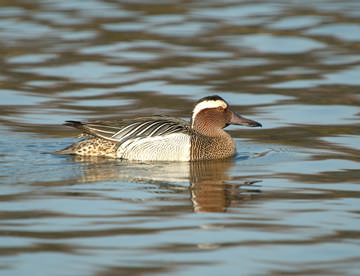Garganey (Anas querquedula)

Garganey © Sue & Andy Tranter
This, our only summer-migrant duck, is here close to its northwestern limit in Britain. The tiny breeding population in Britain, a minute fraction of the estimated 1 million pairs in Europe, is found principally in central and eastern England. Garganeys breed in shallow waters with extensive emergent vegetation, their ideal sites being in open marshland dissected by a network of lushly vegetated ditches and open freshwater pools. They nest in dense patches of aquatic plants such as reed mace Typha or common reed Phragmites australis, and occasionally in damp areas up to 50 m away from the water. Their main food during the breeding season is animal matter: snails, chironomid and other insect larvae, worms, leeches, crustaceans, frog spawn and tadpoles.
They spend the winter in trans-Saharan Africa in the seasonal wetlands across the Sahel. Widespread degradation of their wetland habitat, both in breeding and wintering areas, has led to a significant population decline and Garganey is listed as a species of conservation concern across Europe.
Garganeys are early migrants, with many records in March, and occasional drakes in February, but new birds appear to turn up throughout the spring and summer, and their presence at any site does not necessarily indicate that they bred there (Brown & Grice 2005). In some years the seasons seem to merge and the county bird report finds it impossible to differentiate late spring from early autumn birds.
Climate change is likely to shift more birds farther north to breed in Britain. As with most species at the edge of their range, the numbers seen vary greatly from year to year. The Atlas maps appear to show more birds being recorded in Cheshire and Wirral nowadays than during our First Atlas, although the annual bird reports show that many observers did not include their sightings of Garganey amongst their First Atlas records; despite frequent exhortations to CAWOS members, the same happened during this survey but records submitted for the bird reports have been pooled with the Atlas data. Such ‘observer effects’ make it difficult to tell whether more Garganeys are visiting the county than twenty years ago.
Most observers provided details of the sex of the birds: the only female noted was displaying with two males at Inner Marsh Farm in 2006. The frequent occurrence of odd birds throughout the breeding season led the Rare Breeding Birds Panel to tighten their criteria in 2002 to exclude from their report ‘single birds … which are probably doing little more than just passing through a locality’. Out of the 13 tetrads with records in this Atlas period, probably only those at Inner Marsh Farm in 2006 would qualify for reporting by the RBBP. They are secretive birds and not easy to prove breeding, but, with so few females noted in the county it seems unlikely that Garganeys bred here during this Atlas.
Breeding has only rarely been proven in the county. The most recent year with recorded behaviour suggesting breeding was 1998, when a pair was present in mid-Cheshire from late March to early June, the female disappearing from view for periods of 29 and 22 days, perhaps making two failed nesting attempts.
Sponsored by Michael S. Twist

